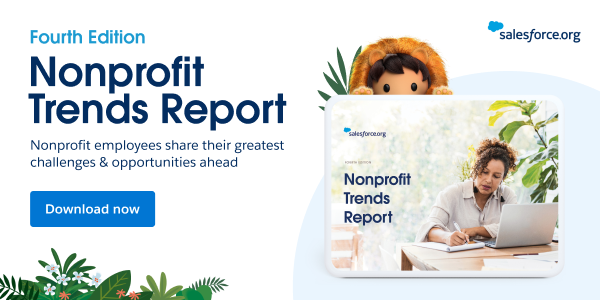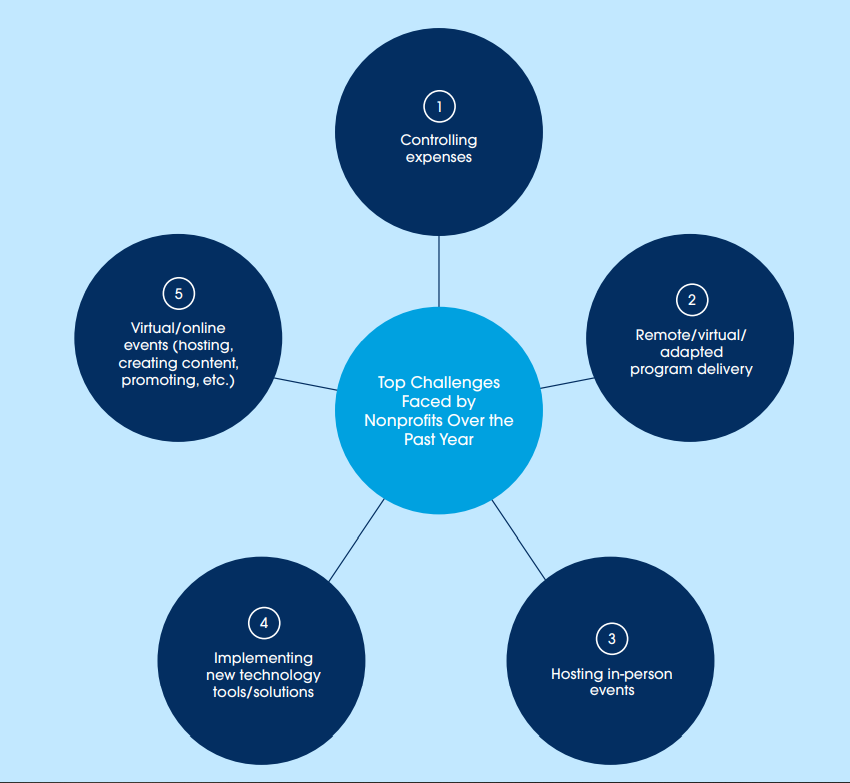Fundraising resilience and innovation in adversity

Sponsored post
In November 2021, Salesforce.org launched the 4th edition of the Nonprofit Trends Report based on data from 1,250 nonprofit professionals in organisations of all sizes across 10 countries.
Generation-defining disruption
Starting in March 2020, nonprofit organisations undertook a breakneck-speed, pandemic-induced pivot — in a sector where rapid change has often been challenging. People and processes faced an unprecedented impetus for digital transformation, alongside huge personal upheaval and stress. Approaches to everything from service delivery to public engagement and fundraising were thrown into revolution overnight. Teams were stretched beyond what was previously imagined possible, as nonprofits faced a dual challenge: balancing risks to income generation while maintaining impact and meeting a rising demand for services. The uncertainty was palpable; the mission was in peril.
And throughout all of this, there was a fundamental shift in how work was undertaken, not least of all the leap to remote working and virtual delivery for many teams. While remote work offered the benefits of flexibility, convenience, and work-life balance, leaders and colleagues increasingly needed to reach out to employees and volunteers to help them feel less lonely and reduce burnout while creating positive outcomes. Teams connected digitally to maintain their spirits, ambition, and collaboration.
Nearly one-third of nonprofits surveyed in the 4th edition of the Nonprofit Trends Report said ensuring the mental health and wellbeing of their employees was a major issue for them over the past year, and 35% anticipated this challenge would increase in the year ahead. This was reflective of the wider growth of mental health as a fundamental societal challenge during the pandemic. Many nonprofits faced another dual challenge in the form of external public and internal staff both in need of support.
Over a decade ago, David La Piana coined the phrase the Nonprofit Paradox to describe how nonprofit organizations are so often plagued by the very ills and cultural challenges they aim to cure in society. The problems nonprofits were trying to solve became front and centre with their own staff — and when it comes to mental health, the stakes are particularly high.
A special kind of resilience
Nonprofit workers are typically highly motivated people with deeply held personal values who are driven to pursue their chosen profession despite its inherent difficulty and significant financial sacrifice. A fundraiser’s top trait is a very particular type of resilience, one that I noted and appreciated firsthand among my colleagues over many years in the sector. This resilience has been tested to the max as fundraisers face unprecedented challenges delivering the income and impact they so vehemently desire. But these individuals became teams, and among the chaos and tragedy also emerged inventiveness, creativity, true collaboration, and transformation.

Innovation to thrive
Necessity was the mother of invention. In the midst of generation-defining disruption, 80% of nonprofits surveyed in the 4th edition of the Nonprofit Trends Report rated their fundraising efforts as more successful than those of others. The fundraising teams that thrived during the pandemic were those that embraced agility and an innovation mindset. The initial scramble of moving offline events and services online has since evolved into recognising data and digital as central to fundraising strategy and success.
As individual giving and digital fundraising continue to demonstrate resilience and growth, traditional manual workarounds in the sector have been exposed and challenged. Streamlined payment management, integrated supporter experience, and marketing automation are necessary building blocks with which to truly grasp the opportunity to upscale this income stream. Regular giving, in particular, is a critical source of predictable unrestricted income at a time of belt-tightening and uncertainty. Nonprofits looked to technology to automate time-consuming manual processes that have often plagued their ability to remain agile, including donor management, gift processing, payroll, financial reporting, and more.
In the 4th Nonprofit Trends Report, 36% of respondents reported they had invested in new technology, such as a CRM, collaboration/productivity tools, analytics, AI, or automation in the previous year, with 87% reporting it as impactful. 42% of those in marketing roles said staff at their organizations have built or explored the development of supporter journeys through connected experiences via the web, social media, email, etc. Digital fundraising has become an increasingly large piece of the fundraising portfolio. But the digital maturity of an organization and its marketing has a large bearing on its ability to assess the effectiveness of its current technology and fundraising.

your digital marketing.
With these changes come a continuously evolving skillset requirement. 31% of nonprofits in the 4th edition of the Nonprofit Trends Report said their employees’ skills no longer fit the needs of their organization. And workforce requirements will continue to change: 76% of nonprofits said they need to develop a data strategy for their organization, and 79% expect to implement widespread use of artificial intelligence (AI) technology in the next three years.
Best Foot Forward
Most of us are long beyond the expectation of a sudden return to “normal,” one that perhaps we originally hoped would be as abrupt as when our world was initially turned upside down. Remote
working, digital fundraising, and virtual events will be with us for some time yet — they are both the present and the future. We need to meet the public, our donors, and our teams where they are.
Nonprofit fundraising and marketing are changing permanently. The difference between nonprofits still struggling to regain their footing and those emerging stronger has been largely determined by their capacity to reimagine their fundraising strategy. While we will gladly return to many traditional fundraising methods, the balance of fundraising portfolios has likely shifted forever. As we tentatively step into a more hopeful future and emerge blinking from a period fraught with intense personal and professional difficulty, how can we retain a healthy appetite for change?
Fundraisers have been dealt a once-in-a-lifetime imperative to forge new paths. Where new digital approaches have served us well, with improved ROI and grown income, capacity must be adapted to continue to leverage success. The importance of innovation has perhaps never been better understood; there is an onus on leadership from the board level down to continue leveraging opportunities for digital transformation. If we can find a silver lining surrounding this huge storm cloud, it’s worth taking advantage of, right?
Digital tools can help us stay resilient amid the constant of change. Click here to download our Nonprofits Trend Report to learn more.

Jane Trenaman, EMEA Nonprofit Advocacy & Fundraising Strategic Industry Advisor at
Salesforce.org


